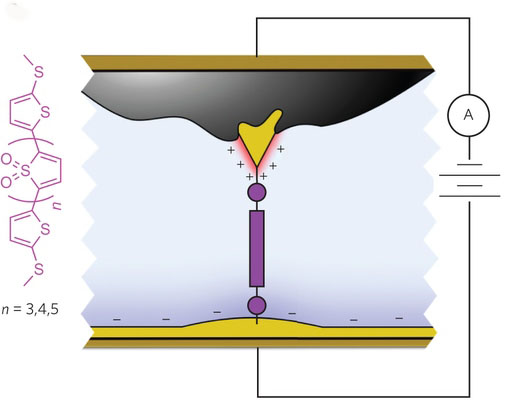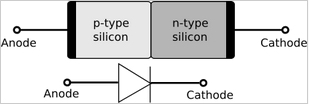A high-performance single-molecule diode
August 3, 2015

Researchers from Berkeley Lab and Columbia University have created the world’s highest-performance single-molecule diode, using a combination of gold electrodes (yellow) and a “TDO” molecule (purple, with molecular structure on the left) in propylene carbonate, an ionic solution (light blue). The circuit symbols on the right represent a battery and an ammeter (A) to measure current flow. (credit: Brian Capozzi et al./Nature Nanotechnology)
A team of researchers from Berkeley Lab and Columbia University has created “the world’s highest-performance single-molecule diode,” using a combination of gold electrodes and an ionic solution.
The diode’s rectification ratio (ratio of forward to reverse current at fixed voltage) is in excess of 200, “a record for single-molecule devices,” says Jeff Neaton, Director of the Molecular Foundry, a senior faculty scientist with Berkeley Lab’s Materials Sciences Division and the Department of Physics at the University of California Berkeley and a member of the Kavli Energy Nanoscience Institute at Berkeley (Kavli ENSI).
Ultimate electronic miniaturization
Single-molecule devices represent the ultimate limit in electronic miniaturization, the researchers say. In 1974, molecular electronics pioneers Mark Ratner and Arieh Aviram theorized that an asymmetric molecule could act as a diode, or rectifier (a one-way conductor of electric current). Diodes have a number of uses in electronic devices.
Since then, development of functional single-molecule electronic devices has been a major pursuit, with diodes — one of the most widely used electronic components — at the top of the list.

A p–n junction (credit: Wikimedia Commons)
A typical current diode consists of a silicon p-n junction between a pair of electrodes (anode and cathode) that serves as the “valve” of an electrical circuit, directing the flow of current by allowing it to pass through in only one “forward” direction. The asymmetry of a p-n junction presents the electrons with an “on/off” transport environment (p–n junctions are elementary “building blocks” of most semiconductor electronic devices such as transistors, solar cells, LEDs, and integrated circuits).
Scientists have previously fashioned single-molecule diodes either through chemical synthesis of special asymmetric molecules (analogous to a p-n junction) or using symmetric molecules with different metals as the two electrodes. However, the resulting asymmetric junctions yielded low rectification ratios and low forward current. Neaton and his colleagues at Columbia University have now discovered a way to address both deficiencies.*
The Berkeley Lab-Columbia University team believes their new approach to a single-molecule diode provides a general route for tuning nonlinear nanoscale-device phenomena that could be applied to systems beyond single-molecule junctions and two-terminal devices, such as ionic liquid gating and two-dimensional materials.
The research is described in Nature Nanotechnology.
* “Electron flow at molecular length-scales is dominated by quantum tunneling,” Neaton explains. “The efficiency of the tunneling process depends intimately on the degree of alignment of the molecule’s discrete energy levels with the electrode’s continuous spectrum. In a molecular rectifier, this alignment is enhanced for positive voltage, leading to an increase in tunneling, and is reduced for negative voltage. At the Molecular Foundry we developed an approach to accurately compute energy-level alignment and tunneling probability in single-molecule junctions. This method allowed myself and Zhenfei Liu to understand the diode behavior quantitatively.”
In collaboration with Columbia University’s Latha Venkataraman and Luis Campos and their respective research groups, Neaton and Liu fabricated a high-performing rectifier from junctions made of symmetric molecules with molecular resonance in nearly perfect alignment with the Fermi electron energy levels of the gold electrodes. Symmetry was broken by a substantial difference in the size of the area on each gold electrode that was exposed to the ionic solution. Owing to the asymmetric electrode area, the ionic solution, and the junction energy level alignment, a positive voltage increases current substantially; a negative voltage suppresses it equally significantly.
“The ionic solution, combined with the asymmetry in electrode areas, allows us to control the junction’s electrostatic environment simply by changing the bias polarity,” Neaton says. “In addition to breaking symmetry, double layers formed by ionic solution also generate dipole differences at the two electrodes, which is the underlying reason behind the asymmetric shift of molecular resonance. The Columbia group’s experiments showed that with the same molecule and electrode setup, a non-ionic solution yields no rectification at all.”
Abstract of Single-molecule diodes with high rectification ratios through environmental control
Molecular electronics aims to miniaturize electronic devices by using subnanometre-scale active components. A single-molecule diode, a circuit element that directs current flow, was first proposed more than 40 years ago and consisted of an asymmetric molecule comprising a donor–bridge–acceptor architecture to mimic a semiconductor p–n junction. Several single-molecule diodes have since been realized in junctions featuring asymmetric molecular backbones, molecule–electrode linkers or electrode materials. Despite these advances, molecular diodes have had limited potential for applications due to their low conductance, low rectification ratios, extreme sensitivity to the junction structure and high operating voltages. Here, we demonstrate a powerful approach to induce current rectification in symmetric single-molecule junctions using two electrodes of the same metal, but breaking symmetry by exposing considerably different electrode areas to an ionic solution. This allows us to control the junction’s electrostatic environment in an asymmetric fashion by simply changing the bias polarity. With this method, we reliably and reproducibly achieve rectification ratios in excess of 200 at voltages as low as 370 mV using a symmetric oligomer of thiophene-1,1-dioxide. By taking advantage of the changes in the junction environment induced by the presence of an ionic solution, this method provides a general route for tuning nonlinear nanoscale device phenomena, which could potentially be applied in systems beyond single-molecule junctions.